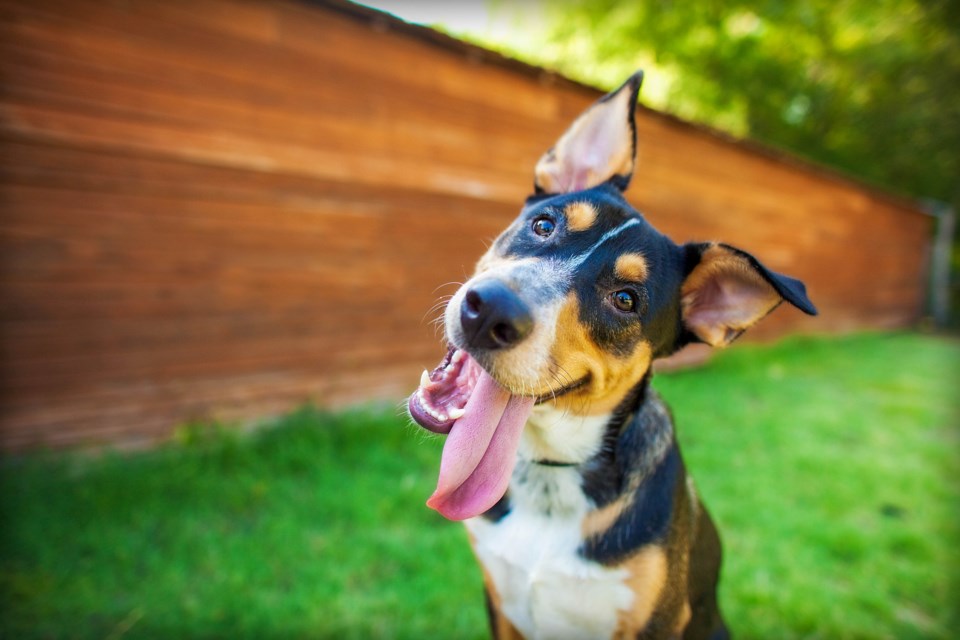The transition from drab brown grass to the lush green lawns enjoyed in the warmer months is a sure sign that spring has sprung. But when your lawn is also where Fido does his business, that green oasis can quickly become overrun by dead spots.
At first, the grass may appear especially green in the areas your pooch chooses for his or her potty. This is because the nitrogen in your pet’s waste acts as a fertilizer.
But as would happen if too much fertilizer was used, the nitrogen will eventually “burn” the grass.
“Most of the effects are from either concentrated urine or feces, with a high concentration of wastes overloading the lawn,” Dr. Steve Thompson, clinical associate professor at Purdue University’s College of Veterinary Medicine and director of the Pet Wellness Clinic, told vetstreet.com
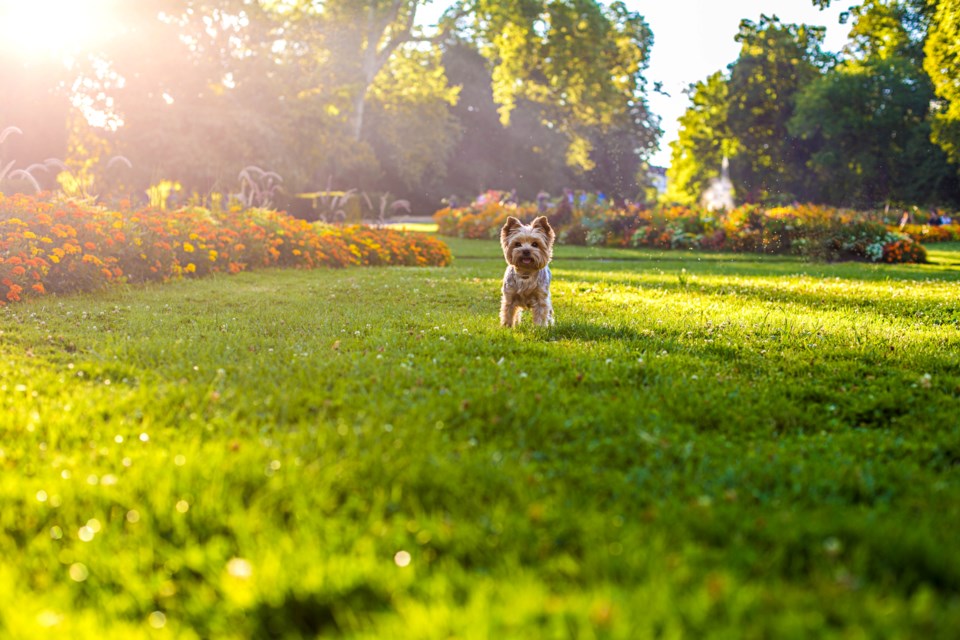
The “urine burn” spots only worsen during dry spells. As the nitrogen in the urine reacts with the soil, it dehydrates the grass and turns it yellow.
A common myth surrounding these unsightly spots is that female dog waste causes more “urine burn” than their male counterparts. In reality, male and female dog urine has similar chemical compositions. The misconception, according to dog-friendly lawn specialists BarkYard, has more to do with how the animal pees.
Because female pups tend to squat in one place, the urine covers a larger surface area. Male dogs tend to lift their leg to aim the urine as high as possible on an object to mark their territory. This elevated spray means the urine slowly drips down and doesn’t cover as much surface area, which can make the urine-damaged areas appear smaller or less noticeable.
While lawn pee spots are nearly inevitable if your dog uses the yard to relieve itself, there are steps pet-owners can take to help reduce those unsightly stains.
Start with H20
This tip is a double whammy and will help dilute the dog’s urine both from the inside and the outside.
Dr. Thompson recommends adding water to dry pet food, which will cause the dog’s urine to have more of a fertilizer effect and less of a burn on some grasses. Additionally, encourage your pup to drink more by giving them access to fresh, clean water more often throughout the day. Allow your dog to have more frequent pee breaks to encourage better hydration.
“Not only will your lawn be happier, your dog will be too,” according to BarkYard. “Drinking water is just as important for dogs as it is for humans, and staying hydrated can protect your dog from kidney and liver issues down the line.”
Keep an eye on your dog and grab the garden hose to rinse the area each time Fido relieves himself. Doing so will instantly diminish any potentially harmful compounds. Skip the rinse to prevent overwatering if the ground is already soggy from recent rainfall.
Clean up the poo
Don’t let feces sit on the lawn. Doggy doo-doo can not only cause nitrogen burn, but it can also lead to lawn fungus. Many fungal lawn diseases will kill the lawn and dog poop provides a moist, nitrogen-rich environment ideal for fungi to thrive.
Additionally, those stinky piles of dog waste can contain parasites and pollutants that can be tracked into your home.
Ideally, “number twos” should be picked up as soon as Fido completes his business or, at the very least, it should be collected weekly. Make sure to use a certified compostable or paper bag when collecting pet feces in order to dispose of the waste in your green residential organics recycling bin.
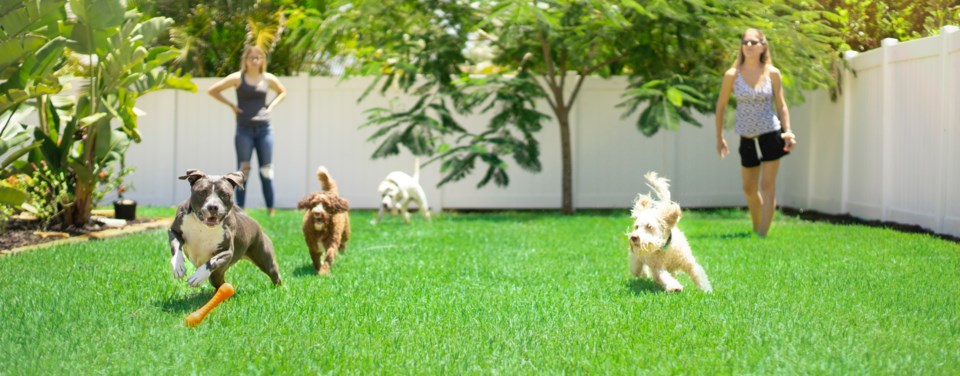
Train Fido where and when to go
While the old saying claims you can’t teach an old dog new tricks, that simply isn’t true. Dogs want to please their owners and can be trained at any age. Teaching your pup to use a specific spot in the yard limits the damaged area and allows you to select a less prominent spot, such as behind a tree or in a shady, out-of-the-way area.
Wherever you decide to locate the doggy bathroom, ensure the space is large enough to allow Fido the option of having a couple of corners to do his business.
Tackle two birds with one stone by leashing your dog and leading them to the same spot every bathroom break. Use a signal word of your choice to direct the pooch to do his business. When Fido pees, praise him and offer a small reward to indicate you’re happy with the behaviour.
“Even if your dog hasn’t taken care of business as a direct response to your command, give them a treat to demonstrate a job well done,” according to BarkYard.
It may take some time, but if you stay consistent, your dog will eventually realize that this is his spot to relieve himself.
Dr. Thompson also suggested adding a post with mulch or pea gravel to create a bathroom spot without grass.
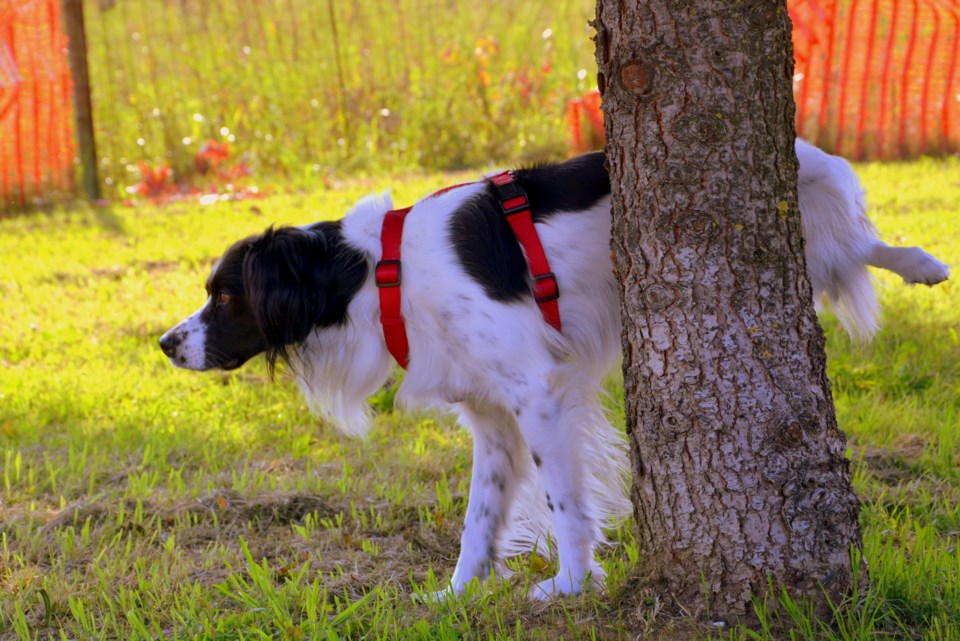
Avoid fertilizer follies
Since pet waste is high in nitrogen, it makes sense not to add nitrogen-rich fertilizer to the same areas. As for the rest of your yard, ensure the products you use are safe for pets. Read the labels to confirm the products have been evaluated for safe use around pets and follow the manufacturer's directions for use.
Choose your grass wisely
Not all grass varieties are created equal, and some can withstand more abuse from pets than others. Fescue and perennial ryegrass are suited to the climate and perform well even when pets are in the picture.
Fescue is hardy and will endure the antics of active dogs. It’s low maintenance, shade-tolerant, and exhibits good drought resistance. Best of all, fescue is absorbent and can handle a large dog’s urine with less impact than other grass varieties.
Perennial ryegrass is another hardy option that is tolerant of dog urine. It does well in cooler climates and quickly and vigorously germinates, though it doesn’t spread very well. However, it’s important to know this type of grass will require more water and fertilizer than other varieties.
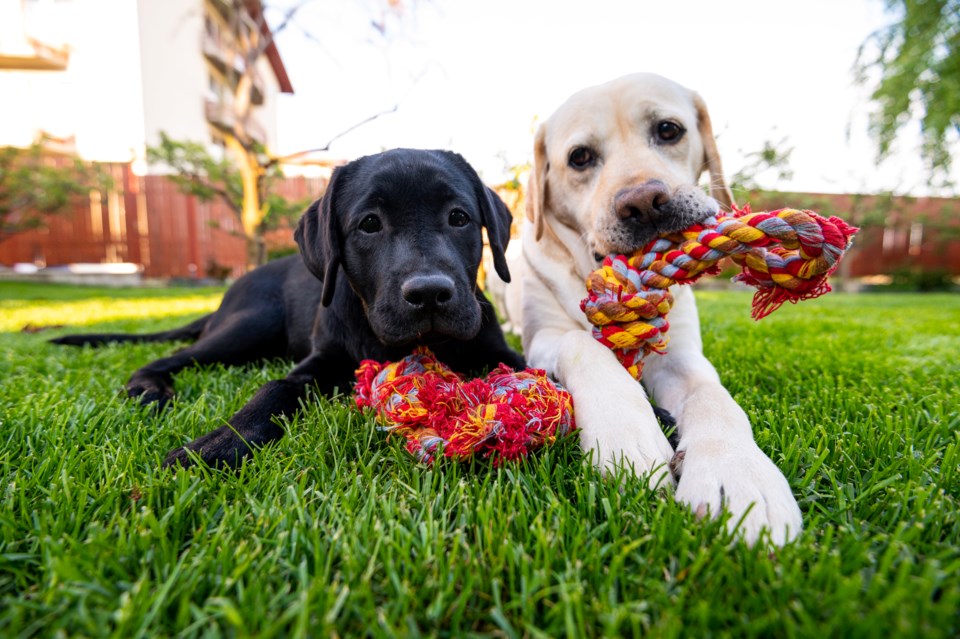
Recovery
If your lawn is overwhelmed by a patchwork of dead, yellow spots, it’s too late for prevention. If the roots have been destroyed, the area will have to be reseeded or the sod will need replacing.
Reseeding
If you do need to reseed, start by removing the dead patch. Use a rake or handheld dethatching tool to pull the dead grass out by the roots. (When done correctly, the dirt will be visible). This process will also agitate the topsoil, which adds oxygen back into it.
Next, water the area slowly. The goal is not to soak the spot, but rather to create a denser topsoil for the seed to take root in.
Reseed the area using a grass mix that includes some fertilizer. Avoid over-seeding, as this will lead to the seeds competing for water, light and air – resulting in poor lawn growth.
Finally, thoroughly water the area, keeping the ground evenly moist until the seedlings reach at least two inches tall.

Replacing sod
Avoid future lawn maintenance nightmares by removing all the old sod and cleaning any debris left behind.
Dampen the underlying soil before laying the new sod. Failure to do so will prevent the new sod from taking root, which will kill the grass. You might also consider adding new soil and composting to create a nutrient-rich foundation for the grass.
Lay the sod, ensuring you tuck in the edges to secure the sod in place. It is important to dampen the sod as you lay it to allow it to take root faster.
Whether reseeding or replacing sod, maintaining a consistent watering, mowing, and feeding routine will help encourage your lawn to grow and remain luxurious. You might consider letting the grass grow a little longer as the lawn repairs itself.
Leaving the grass at about three inches or higher can disguise damage from dog pee and has the added benefit of helping pollinators such as bees and butterflies survive.
